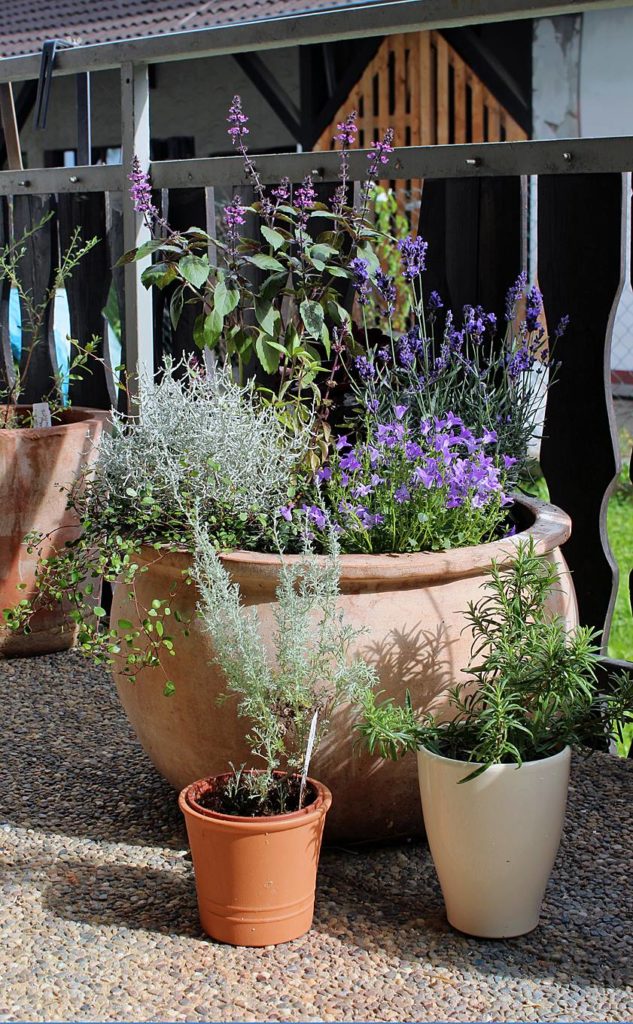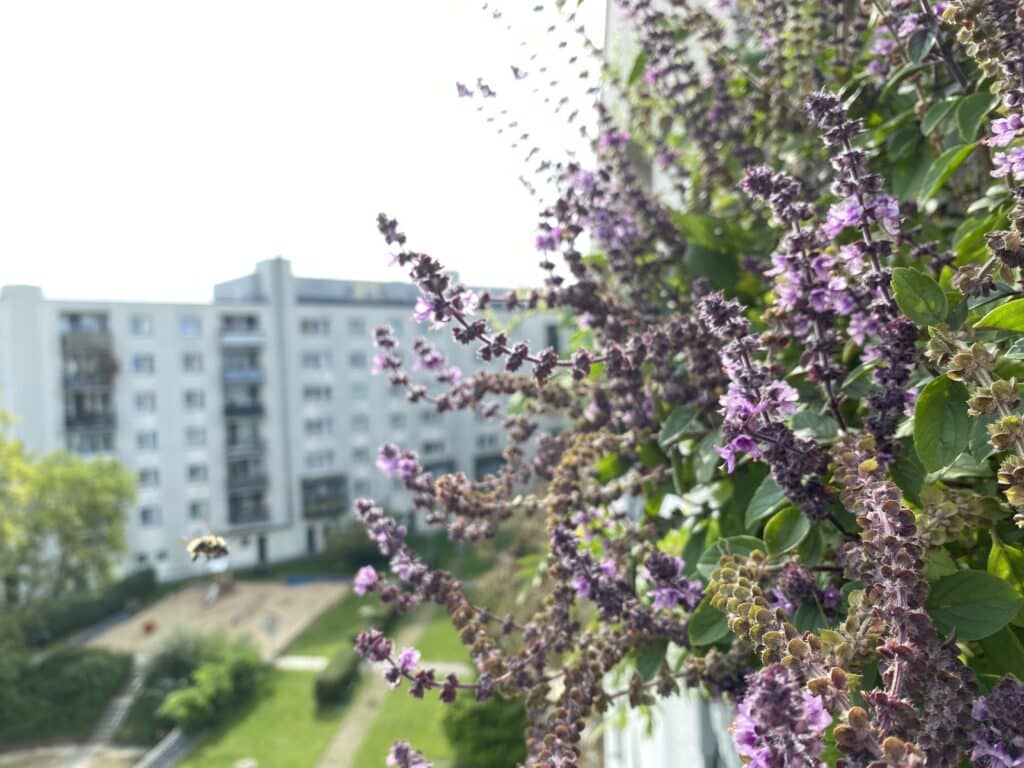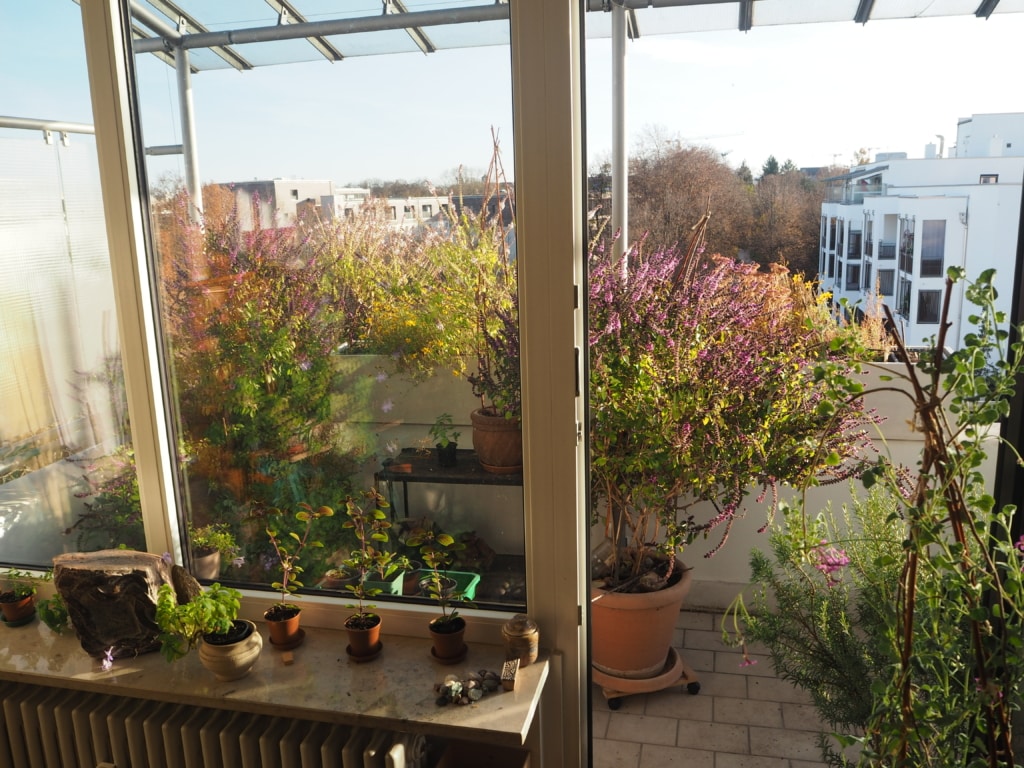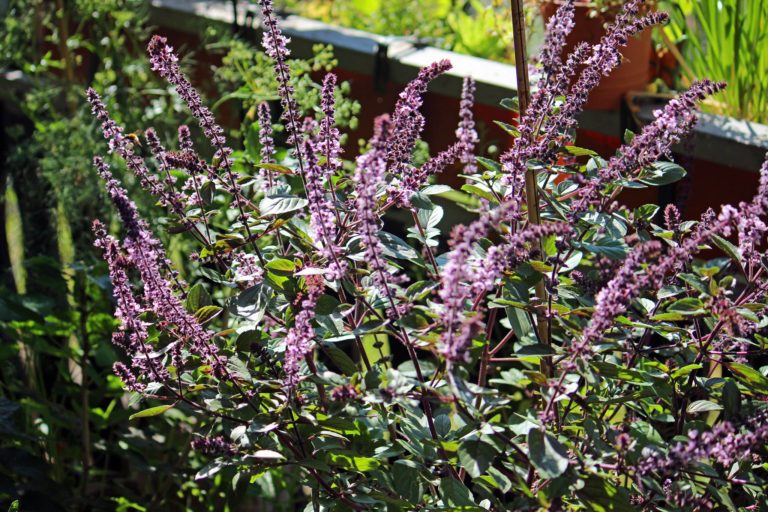Some people have bush basil on their balcony or in the flower bed every year. It also tastes really delicious. Overwintering is difficult, as shrub basil is not frost-hardy. Wintering it indoors or in a cool hallway can work. Place the shrub basil in a bright, cool window and let it overwinter there. Put it out again in spring after the Ice Saints, it will flower again and delight you and the bees! It also tastes delicious.

You can therefore try to keep the mother plant in a bright, frost-free place (10 to 15 degrees, even cooler is better, but frost-free) over the winter. If the conditions are not ideal, whiteflies, spider mites and the like can appear and gain the upper hand. To be on the safe side, you can cut cuttings and overwinter them indoors in a cool, bright bedroom. If the large plant does not make it .…
How to cut cuttings: Cut young, healthy and non-woody shoots without flower buds that are approx. 8 — 10 cm long. If all the branches have flowering shoots, then cut the branches appropriately so that the energy goes into root formation first. Flower shoots may emerge from the leaf axils. They will probably get roots anyway! Feel free to remove a few leaves to reduce evaporation. These will root after a short time in the glass of water. Alternatively, you can put the cuttings in potting compost and grow them in the soil straight away. This variant can also work. Always keep the plant substrate slightly moist, but not too wet. A plastic bag over the plant container improves the climate for rooting, but is not absolutely necessary. Ventilate regularly to prevent mold growth.

The experienced gardener from the Facebook group for the Organic Balcony Congress raved about her shrub basil: “Mine has actually grown a meter tall from the edge of the pot, I’ve had to cut it back a few times in width! Next year the plant will go into a corner and can grow out over the edge of the balcony. She sent me cuttings of the bush basil by post. Well packed in a wet cloth, wrapped in a bag. The sturdy cuttings, which were cut just 14 days ago, have put down great roots. They will go into the ground, hopefully survive the winter and can then go out onto the balcony in the spring.

I am now writing this article about bush basil out of the joy of these cuttings. Hopefully it will enchant readers who will then be happy to take bush basil onto their balcony and give cuttings to other balcony owners as gifts! Contagion of the best kind! It all started when the experienced gardener offered to send me cuttings. It gets bigger and bigger. Like the small cuttings from the bush basil.
Final arguments: Unlike almost any other plant, the flowering period extends from the end of May until the first frost in late fall. This means that they provide nectar and pollen over a very long period. We always see wild bees, bumblebees and butterflies on them. The beautiful, often deep dark leaves of the various shrub basil varieties are beautiful. It tolerates drought well, but can also cope with the opposite and is absolutely balcony box tolerant, although it will grow more sprawling in larger planters. The flowers can be used just like the leaves; you can simply strip them from the panicles and don’t even have to chop them up. When dried, the flowers retain their aroma, which can be saved for the winter.

You can buy organic shrub basil online here:
Gaissmayer perennial nursery
Kräuterei Manufaktur for greens and sweets
But only put it out in spring, basil is not frost-hardy. Shrub basil tolerates temperatures of up to 5° C for short periods when protected. As always, leave outside for as long as possible and put out early in spring, carefully acclimatize to the sun and cut back.
Experience with overwintering shrub basil via cuttings
Experiences of herb gardener Carolin Urban from the Urban herb garden: “The handling of shrub basil is quite complicated and often not crowned with success… Our experience is: cool (5–10°C) and as bright as possible (in winter rather south). Plants should be as large as possible with a proper stem and leaves, but no flowers (harvest!). And then nurture and hope. In my experience, cuttings rarely make it in apartments. The stronger the plant, the more power it has to sprout again from the old wood. Paprika basil overwinters well and easily. But it also tastes quite special…” So it worked for me again over the winter of 2022 with cuttings.
Very positive feedback on the success of propagation via cuttings from Martin Lell. Thank you for allowing me to share the November picture of your giant bush basil, the cuttings and your experiences here. Very impressive!

“I can fully agree with Birgit’s cuttings instructions, it actually always works, you usually have roots after just one week. It also works well to put the cuttings with the leaves removed at the bottom into coconut pots (make a small hole in the middle, put the cuttings in and then press the soil around them firmly) and then root them in a mini greenhouse on the windowsill (ventilate once a day). This way you can easily root 10 plants at once and you can observe how the roots sprout from the pots. From then on, the new plants can be placed in normal pots on the windowsill. As with all cuttings, however, you should keep them warm during rooting (around 20 degrees), otherwise it can take a long time at much colder temperatures.
New cuttings are also a good way to save the basil plants over the winter. I bought a red (pink in the heat) flowering shrub basil “African Blue” in 2016 and have been making small (approx. 5 cm long cuttings from side shoots) from it every fall since then, which I overwinter. I usually cut the cuttings in October, at least before the first frost.
I overwinter them in a south-facing window without artificial light. The plants grow throughout the winter (around Christmas, of course, not very much due to the lack of light), but by the beginning or middle of May they are already 60 — 70 cm tall bushes (if you tie up the longest branches) and by the fall you have about 1 m x 1 m or even larger bushes on the balcony (and of course it hums from May to November and butterflies such as lady butterflies come to visit).
Overwintering also works in the same way for white-flowering shrub basil, as well as for the “Wild Purple” variety and Rühlemann’s Persian (spice) basil.
I don’t think it’s a good idea to overwinter the old shrubs, as has already been suggested. Indoors, there is usually a lack of space and, above all, the light that the large shrubs are used to from being on the balcony. There are always a few aphids on the bushes, possibly also whiteflies or small cicadas or leaf bugs, which then multiply explosively indoors in winter when it is hot, while the plants get worse and worse due to a lack of light. It can then easily happen that the “guests” spread to the rest of the houseplants. However, the small cuttings can be easily screened or briefly washed and then only overwinter what you want to keep indoors.”









25 Responses
Many thanks for the tip about the cuttings! This is the third year I’ve had this basil on my balcony and I’m delighted with the abundance of bees. I bought a new plant every year because the frost wouldn’t let it survive.
I’ll try to overwinter them this year!
Kind regards Nina
This is the first time I’ve had shrub basil in the garden and I will of course try to overwinter the mother plant. I will of course also try taking cuttings. Thanks for the tip.
Kind regards
Andrea
Shrub basil is THE substitute for lavender for bees and bumblebees after the lavender flowers have faded. I have x bee plants in the front garden and on the balcony. But the bees are very interested in the shrub basil.
On the subject of cuttings: it’s simple: cut off 1 branch — remove the lower leaves (in the salad or on the spaghetti), put them in a glass of water and bang: after about 2 weeks they have taken root. Shrub basil grows just as well in seramis as in well-drained potting soil. They are fertilized approx. every 1–2 weeks with herb fertilizer, for Seramis liquid fertilizer. For me, I grew 2 small stem trees that should not flower for harvesting (extremely tasty pesto) and several small stem trees and bushes for bee food. They are still buzzing — even now in mid-September. What a great joy. A great plant all round. In winter, my little trunk trees are in a bright and cool place and usually survive, but I always have replacement plants in Seramis ready in case there are any problems. Best regards, Cio
Dear Cio, great. Thank you so much for sharing your experience. It’s great that you confirm that it’s a great plant for us and for the bees at the same time. We love plants like that. Kind regards Birgit
I discovered the shrub basil by chance at the weekly market…I bought 3 pots straight away…it had variegated leaves in addition to the pretty flowers…
Since I now live in the middle of the city, it has become a real magnet for the few bees and bumblebees…it is also delicious…I will buy it again soon…
A very good decision on your part. They are fragrant, beautiful bumblebee magnets. They also grow nice and big, I really like them too. You can overwinter them, I think that’s always important, so that we don’t always have to buy new ones. Kind regards Birgit
Thank you very much for this article!
I have always bought Asian shrub basil from the gardener for 3 years for the wild bees. This year even 6 pots. They didn’t grow that big but I was delighted by the rush of insects.
One overwintering last year failed. But I also think I put the pots in too late? Frost was not to blame.
My question now is, when do I put the plants away? And when do I make the cuttings?
I also got some seeds in the spring, so you can give it a try.
Thank you very much for your reply! And of course I will share the article on Facebook.
Best regards
Christina Stiller
Dear Christina, I’m pleased that my article already provides good information. My website has just moved, so the pictures are not yet visible. I still have a lot of work to do to add all the pictures to the many blog posts :). When it gets cold in the fall, make sure you move early enough to avoid frostbite. If the thermometer drops below 10° Celsius, the plants should be moved into a warm house. Place them on a windowsill for the time being, then move them to a cooler place for the winter. Late summer/autumn is the right time for the cuttings. I would take some now because there is still so much vigor left. Kind regards Birgit
The plant was recommended to me at the weekly market as being bee-friendly. It’s a real joy to watch the countless bees and bumblebees. As I didn’t know it would grow so big, I chose a pot that was too small at the beginning. Thank you very much for all the information on propagation by cuttings and the possibility of overwintering. I will try both.
Kind regards
Martina
Dear Martina, I also have two bush basil plants this summer — in a balcony box on my son’s windowsill. They look wonderful. And bees are also coming to the windowsill. Good luck for the winter. Best wishes Birgit
Dear Christina, this year I have 6 bush basil plants on my balcony. A real feast for bees and bumblebees. What do I do with withered shoots? Cut them off or leave them? Thank you for your help.
Dear Jutta, I leave them on. There are so many flowers on the basil bush that the bumblebees always find enough to eat. I really enjoy my plants, the color is so great, there are lots of bumblebees, and they taste great with the tomatoes. The scent is so nice. Kind regards Birgit
Dear Birgit, the message was meant for you. I got mixed up with the first names.
Hello, when do you have to cut back the shrub if you want to overwinter it? Bees and bumblebees are still coming, but most of the flowers have already faded.
Dear Bine, there is still time, I leave the flowers on, so there is still food for the bumblebees. If it gets cold in the fall, make sure you move early enough to avoid frostbite. If the thermometer drops below 10° Celsius, the plants should be moved into a warm house. Place them on a windowsill for the time being, then move them to a cooler spot later in the winter. Late summer/autumn is the right time for the cuttings. I would take some now because there is still so much vigor left. So try to overwinter the plant in the house/apartment and take cuttings at the same time. Good luck! Kind regards Birgit
I also saved the shrub basil over the winter with a cutting, it is now a good 70 cm tall. When there are no more small flowers to be seen, I make a tea from the fruit. The hot water first turns turquoise and then blue, which looks wonderful. The plant also sprouts plenty of leaves again, which I like to use for seasoning.
Dear Johanna, thanks for the tip. This is how we continue to inspire with turquoise-blue tea. Kind regards Birgit
I bought the “African Blue” on the first day of my rehab and put it on the balcony of my room. Within a very short time, bees were there and even a titmouse dropped by. Within three weeks, the deer garden had grown from the African Blue into two boxes and even a small swamp bed. Everything came home with me safe and sound and is now thriving in more space. I’ve added a white-flowering shrub basil to the African Blue — it’s always busy there, looks beautiful and I can’t walk past without rubbing the leaves and enjoying the scent.
Dear Enrica, I will probably never forget your stay at the spa and the development of the rehab balcony garden. You inspired us all with your pictures in our FB group and your irrepressible desire for plants and gardening took us along with you. There are also so many great varieties of bush basil that we are still discovering. Unfortunately, our space is always limited, but we are good at improvising. Kind regards Birgit
Dear Birgit,
Thank you for the great information about the much-loved basil, regardless of the variety and form!
Dear Rita, basil is such a great plant. For me, I feel like I’m only just discovering it and the journey is just beginning. Bush basil belongs on every balcony — just like the variety of bluebells, purple loosestrife, sunflowers and an apple tree :). Kind regards Birgit
Dear Rita!
How do I grow basil cuttings?
Dear Rita, it’s very easy. This is how you cut cuttings: Cut young, healthy and non-woody shoots without flower buds that are approx. 8 — 10 cm long. If all the twigs have flower buds, then cut the twigs appropriately so that the energy goes into root formation first. Flower shoots may emerge from the leaf axils. They will probably get roots anyway! Feel free to remove a few leaves to reduce evaporation. These will root after a short time in the glass of water. Alternatively, you can put the cuttings in potting compost and grow them in the soil straight away. This variant can also work. Always keep the plant substrate slightly moist, but not too wet. A plastic bag over the plant container improves the climate for rooting, but is not absolutely necessary. Ventilate regularly to prevent mold growth. Good luck! Kind regards Birgit
Dear Birgit, I see this post years later and would also like to do something for the bees on a south-facing balcony, which gets very little light due to a lime tree and beech tree in front of it and is rather cool. A wide building wall to the east…
Since I have stored bamboo sticks upright on the balcony and the wild bees are actively using them for breeding purposes, I guess the bees would be really grateful for any further help.
Now my question: what do you think is the best basil substrate for tall balcony pots that are hung over the balcony railing? I have already filled in gravel at the bottom for drainage. Now I was thinking of vegetable or growing soil and possibly your much-praised worm fertilizer and compost tea made from it? Or would it be better to buy the sheep’s wool pellets? Or rock fertilizer?
What do you think of Seramis, as someone wrote in the comments, to ensure good watering? Should sand be added to the soil?
As the basil is also eaten, I want to use completely natural materials.
Thank you so much Birgit, I’ve been following some of your balcony conferences — but unfortunately don’t have the time at the moment — so I just searched for “worm compost” with basil using an AI search tool and immediately your site came up as a helpful resource.
Hier teile ich Erfahrungen von Anja:
Ich mache das seit vielen Jahren. Einmal ist es mir nicht gelungen und die Pflänzchen sind abgestorben, das war, als ich diese zu spät eingepflanzt hatte.
Bei mir funktioniert es wie folgt: Spätestens im Juli müssen die im Wasser bewurzelten Stecklinge in Erde. Da ich festgestellt habe, dass sie in der Tomatenerde unter den Tomaten förmlich im Wachstum explodieren, erhalten sie in den Topf einen Teil dieser Tomatenerde. Ich habe immer mehrere Töpfe davon parallel, weil ich immer einen Teil für die Bienen lasse.
Ende August werden an den Töpfen, die ich überwintere, die langen blühenden Triebe zurückgeschnitten, sodass die Pflanze im September nochmal schön Blätter ausbilden kann. Zu diesem Zeitpunkt hat sie einen kräftigen Wurzelballen. Sobald Frost angesagt ist, wandert sie an mein Schlafzimmerfenster oder den aufgestellten Tisch davor, weil da noch mehrere Töpfe stehen. Das liegt im Osten und im Schlafzimmer ist es immer frisch bis sehr kalt, weil ich auch im Winter bei offenem Fenster schlafe. Nur tagsüber mache ich es zu. In Zugluft stehen sie allerdings nicht, weil sie auch sehr frostempfindlich sind. Ich achte darauf, dass die Pflanzen nicht vertrocknen und gieße ab und zu.
Ab März kommen die Töpfe ins warme Wohnzimmer und gewöhne sie am Balkon tagsüber auch schon an die Sonne.
Das wars. Es ist wirklich easy, wenn die Stecklinge schon schön eingewurzelt sind, also nicht erst kurz vor dem Winter. Ich denke, das ist der Punkt.